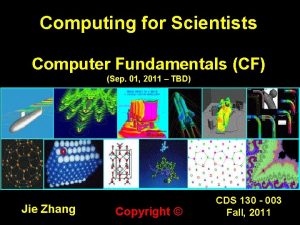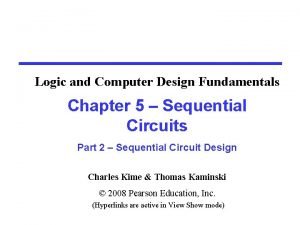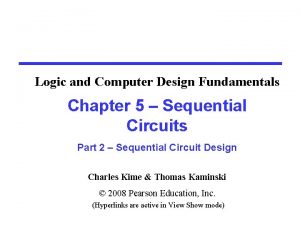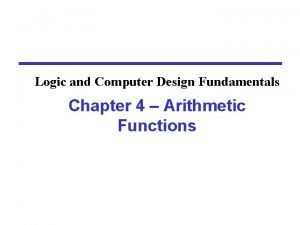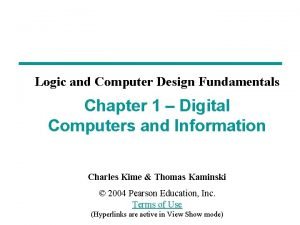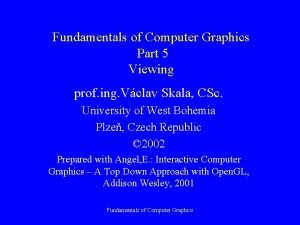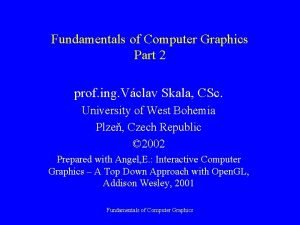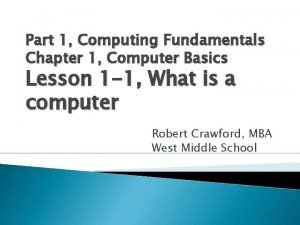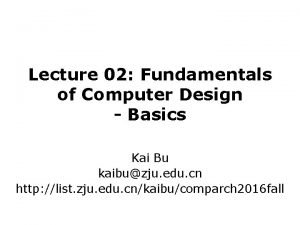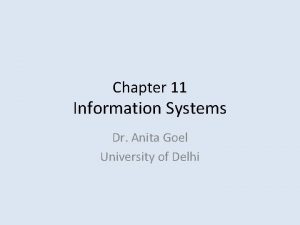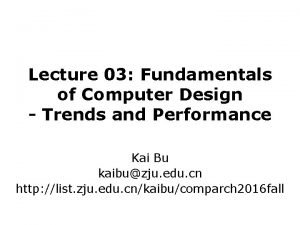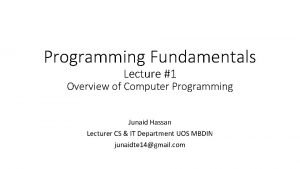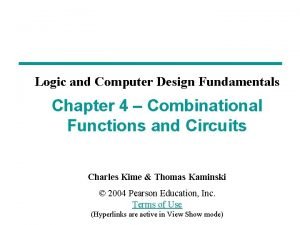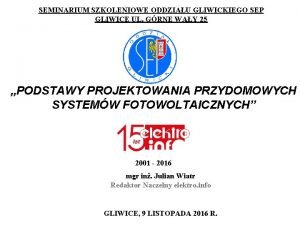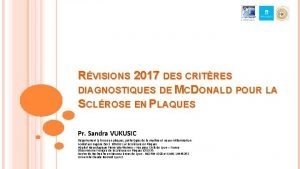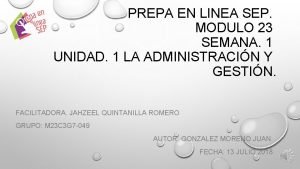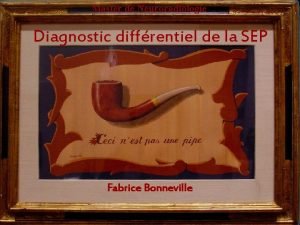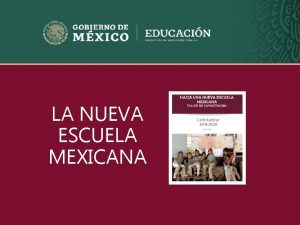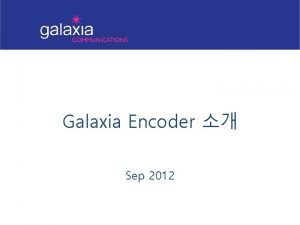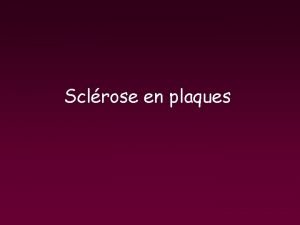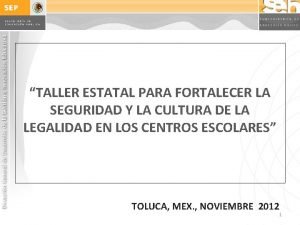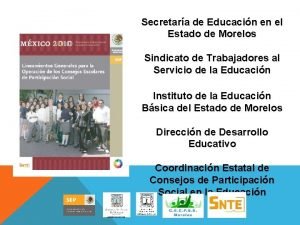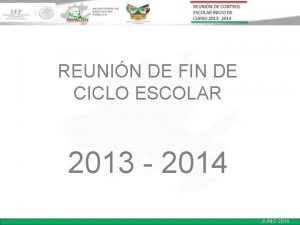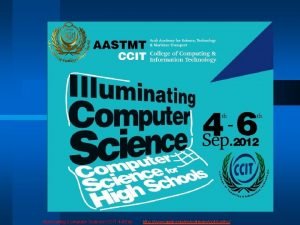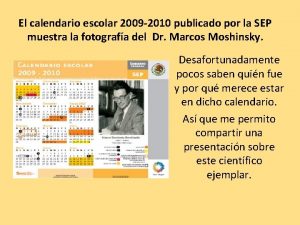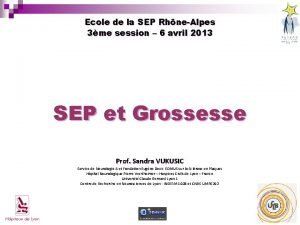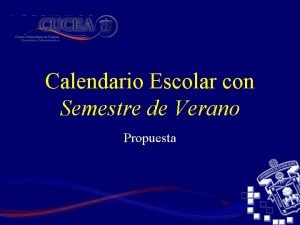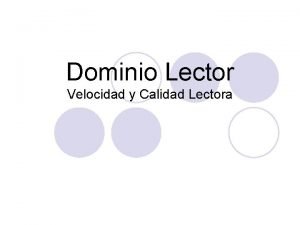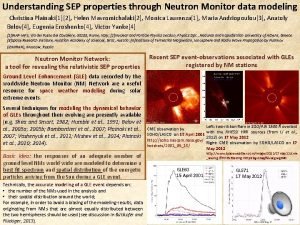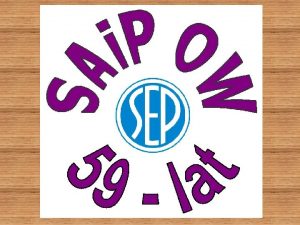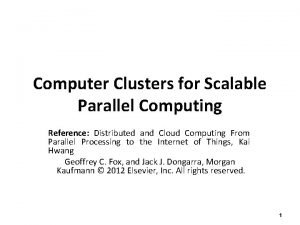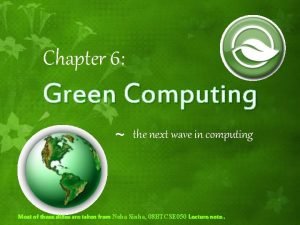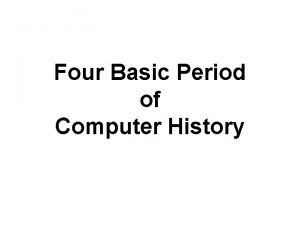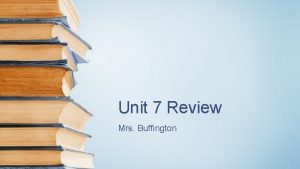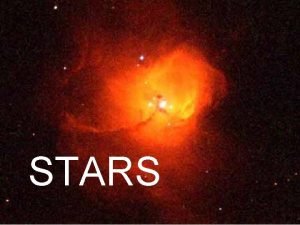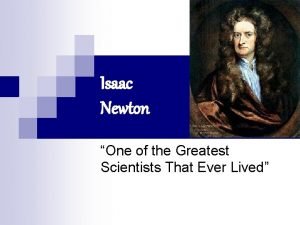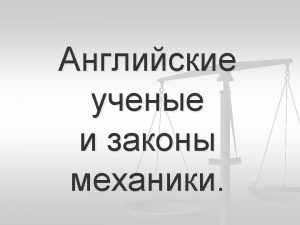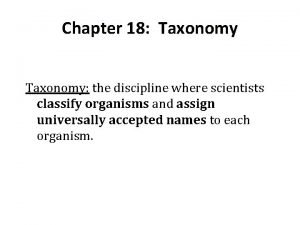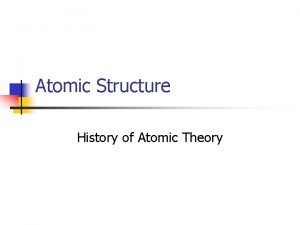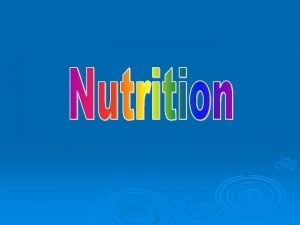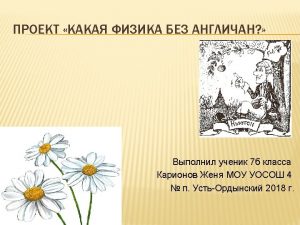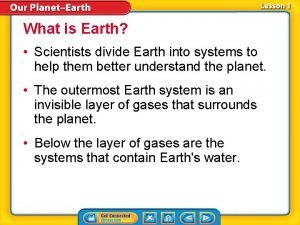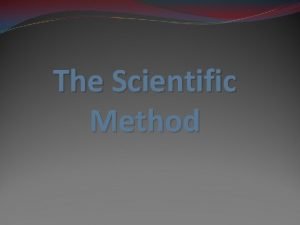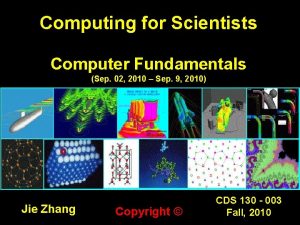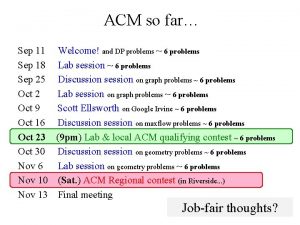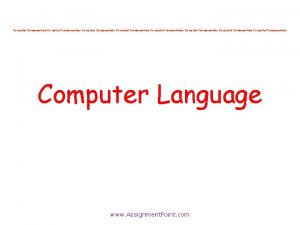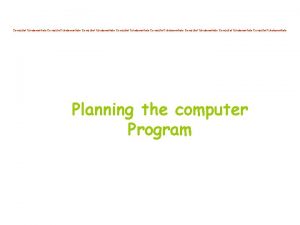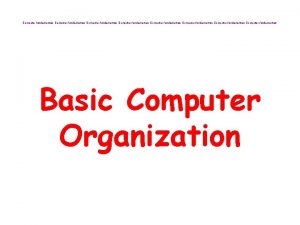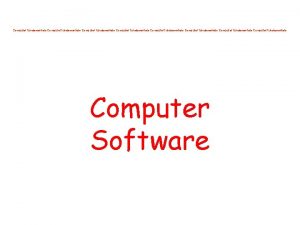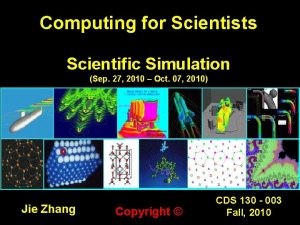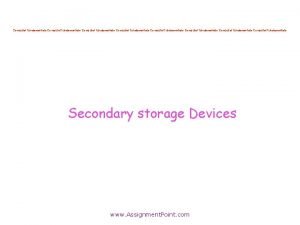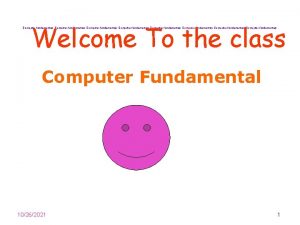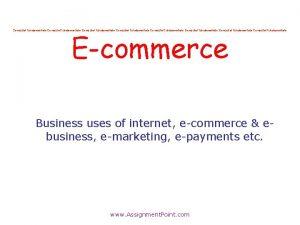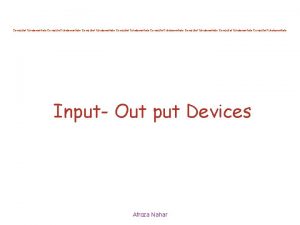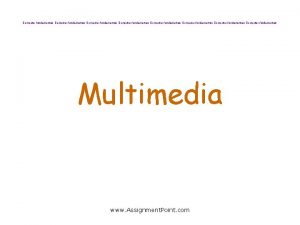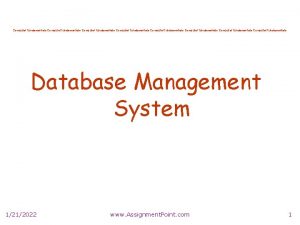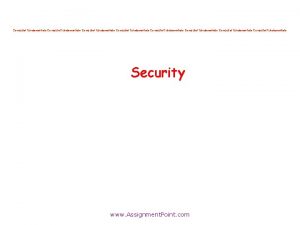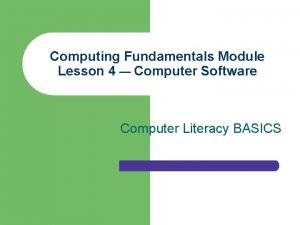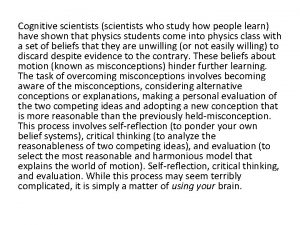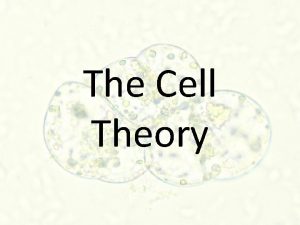Computing for Scientists Computer Fundamentals CF Sep 01






































































































![Transistors “About 60 million transistors were built this year [2002]. . . for [each] Transistors “About 60 million transistors were built this year [2002]. . . for [each]](https://slidetodoc.com/presentation_image/2d20e725956a190fb42914ca3646c36c/image-103.jpg)




























- Slides: 131

Computing for Scientists Computer Fundamentals (CF) (Sep. 01, 2011 – TBD) Jie Zhang Copyright © CDS 130 - 003 Fall, 2011

Computer Fundamentals (CF) 1. Binary Representation • “Convenience” of using 0 and 1 2. Binary Operations 3. Data Storage and Binary Encoding • How to store 0 and 1 4. Logic Circuit and Logic Table: • How to process 0 and 1

CF 1: Binary Representation (Sep. 1, 2011)

Objectives • Understand why the binary representation of numbers is important • Understand the different ways of representing numbers • Be able to convert from binary to decimal and decimal to binary • Be able to do calculations with binary numbers: addition, subtraction, multiplication, (division)

Power of 0 无生有,有生二,二生三,三生万物 - The teach of Daoism First God made heaven & earth. The earth was without form and void, and darkness was upon the face of the deep; and the Spirit of God was moving over the face of the waters. And God said, "Let there be light"; and there was light. - Bible Big Bang Model of the creation of our universe -Modern Astronomy

Arabic Numerals 0123456789 Arabic numerals or Hindu numerals are the ten digits (0, 1, 2, 3, 4, 5, 6, 7, 8, 9). They are descended from the Hindu-Arabic numeral system developed by Indian mathematicians. The Indian numerals were adopted by the Persian mathematicians in India, and passed on to the Arabs further west. From there they were transmitted to Europe in the Middle Ages. The use of Arabic numerals spread around the world through European trade, books and colonialism. Today they are the most common symbolic representation of numbers in the world -http: //en. wikipedia. org/wiki/Arabic_numerals

Decimal Numeral Numbers • It is based on the Arabic numeral system. • It uses positional notation • Use same symbols for different orders of magnitude, but in different places, e. g. , 1 st place (ones place), 2 nd place (tens place), 3 rd place (hundreds place). • Example: In decimal, 1478 means • 1 unit of 1, 000 • 4 units of 100 • 7 units of 10 • 8 units of 1 1000+400+70+2=1478

Decimal Template • Use power notation, which relates the place and the value of one unit in that places

Decimal Template 1 x 103 + 4 x 102 + 7 x 101 + 8 x 100 Or, we could construct a template, like this, and just fill in the numbers : 1 4 7 8 103 102 101 100 (1000) (10) (1)

Binary Numeral Numbers • It is based on the binary representation (0, 1). • Machines like binary representation • Much easier to create two states, instead of ten states • A binary number also uses positional notation • Use the same symbols for different orders of magnitude, but in different places, e. g. , 1 st (ones) place, 2 nd (twos) place, 3 rd (fours) place, 4 th (eights) place • Example: In binary, 1101 means • 1 unit of 8 • 1 units of 4 • 0 units of 2 • 1 units of 1 8+4+0+1=13

Binary Template 1 1 0 1 26 25 24 23 22 21 20 (64) (32) (16) (8) (4) (2) (1)

Binary Numeral Numbers Binary Decimal Binary 0 0 1 1 10 2 2 10 100 4 3 11 1000 8 4 10000 16 5 101 100000 32 6 110 1000000 64 7 111

Let’s Do It Again! Let’s say I have the following binary number: 1011011 Fill in the template, beginning from the right. . . 1 0 1 1 26 25 24 23 22 21 20 (64) (32) (16) (8) (4) (2) (1) 1 unit of 64 0 units of 32 1 unit of 16 1 unit of 8 0 units of 4 1 unit of 2 1 unit of 1

Again. . . 1 unit of 64 0 units of 32 1 unit of 16 1 unit of 8 0 units of 4 1 unit of 2 1 unit of 1 That is, 1 x 64 + 0 x 32 + 1 x 16 + 1 x 8 + 0 x 4 + 1 x 2 + 1 x 1 Or, 64 + 0 + 16 + 8 + 0 + Or, 91 (written in base ten) 2 + 1

Practice Doing It a Few More Times Convert the following binary numbers to base ten: 1. 2. 3. 4. 5. 11 100 10101 100001 111111 27 26 25 24 23 22 21 20 (128) (64) (32) (16) (8) (4) (2) (1)

Practice Doing It a Few More Times -- ANSWERS Converted binary numbers: 1. 2. 3. 4. 5. 3 4 21 33 63 27 26 25 24 23 22 21 20 (128) (64) (32) (16) (8) (4) (2) (1)

Now, Let’s Go BACKWARDS: (Base Two, or Binary Base Ten) Problem: Convert 45 (base ten) to binary

Backwards. . . 45 Rule: Since we’re working with binary, we have ONLY TWO SYMBOLS to work with: 0 and 1. ? 27 26 25 24 23 22 21 20 (128) (64) (32) (16) (8) (4) (2) (1)

Backwards. . . 45 BEGIN FROM THE LEFT Ask: “How many units of 128 are contained in 45? ” Zero! (None) 0 27 26 25 24 23 22 21 20 (128) (64) (32) (16) (8) (4) (2) (1)

Backwards. . . 45 Ask: “How many units of 64 are contained in 45? ” Zero! (None) 0 0 27 26 25 24 23 22 21 20 (128) (64) (32) (16) (8) (4) (2) (1)

Backwards. . . 45 -32 13 Ask: “How many units of 32 are contained in 45? ” One! Then, TAKE IT OUT. . . 0 0 1 27 26 25 24 23 22 21 20 (128) (64) (32) (16) (8) (4) (2) (1)

Backwards. . . 45 -32 13 Ask: “How many units of 16 are contained in 13? ” Zero! (None) 0 0 1 0 27 26 25 24 23 22 21 20 (128) (64) (32) (16) (8) (4) (2) (1)

Backwards. . . 45 -32 13 -8 5 Ask: “How many units of 8 are contained in 5? ” One! Then, TAKE IT OUT. . . 0 0 1 27 26 25 24 23 22 21 20 (128) (64) (32) (16) (8) (4) (2) (1)

Backwards. . . 45 -32 13 -8 5 - 4 1 Ask: “How many units of 4 are contained in 5? ” One! Then, TAKE IT OUT. . . 0 0 1 1 27 26 25 24 23 22 21 20 (128) (64) (32) (16) (8) (4) (2) (1)

Backwards. . . 45 -32 13 -8 5 - 4 1 Ask: “How many units of 2 are contained in 1? ” Zero! (None) 0 0 1 1 0 27 26 25 24 23 22 21 20 (128) (64) (32) (16) (8) (4) (2) (1)

45 -32 13 - 8 5 - 4 1 - 1 0 Backwards. . . Ask: “How many units of 1 are contained in 1? ” One! Then, TAKE IT OUT. . . 0 0 1 1 0 1 27 26 25 24 23 22 21 20 (128) (64) (32) (16) (8) (4) (2) (1)

CONGRATULATIONS!! 45 IN BASE TEN IS 00101101 IN BASE TWO, OR, IN BINARY! 4510 = 001011012 4510 = 1011012 0 0 1 1 0 1 27 26 25 24 23 22 21 20 (128) (64) (32) (16) (8) (4) (2) (1)

Long Division Method • Always divide by 2 • Divide each new quotient by 2 and write the remainders to the right. Stop when the quotient is 0 • The top remainder is the least important, and the bottom remainder is the most important. • Start from the bottom remainder, read the sequence of remainders upwards to the top. • Exp: what is decimal 13 in binary? 2)13 1 2)6 0 2)3 1 2)1 1 0 The answer: 1101

One More Time! (Base Two, or Binary Base Ten) Problem: Convert 9710 to binary

97 One More Time! BEGIN FROM THE LEFT Ask: “How many units of 128 are contained in 97? ” Zero! (None) 0 27 26 25 24 23 22 21 20 (128) (64) (32) (16) (8) (4) (2) (1)

97 - 64 33 One More Time! BEGIN FROM THE LEFT Ask: “How many units of 64 are contained in 97? ” One! Then, TAKE IT OUT. . . 0 1 27 26 25 24 23 22 21 20 (128) (64) (32) (16) (8) (4) (2) (1)

97 - 64 33 - 32 1 One More Time! BEGIN FROM THE LEFT Ask: “How many units of 32 are contained in 33? ” One! Then, TAKE IT OUT. . . 0 1 1 27 26 25 24 23 22 21 20 (128) (64) (32) (16) (8) (4) (2) (1)

97 - 64 33 - 32 1 One More Time! BEGIN FROM THE LEFT Ask: “How many units of 16 are contained in 1? ” Zero! (none) 0 1 1 0 27 26 25 24 23 22 21 20 (128) (64) (32) (16) (8) (4) (2) (1)

97 - 64 33 - 32 1 One More Time! BEGIN FROM THE LEFT Ask: “How many units of 8 are contained in 1? ” Zero! (none) 0 1 1 0 0 27 26 25 24 23 22 21 20 (128) (64) (32) (16) (8) (4) (2) (1)

97 - 64 33 - 32 1 One More Time! BEGIN FROM THE LEFT Ask: “How many units of 4 are contained in 1? ” Zero! (none) 0 1 1 0 0 0 27 26 25 24 23 22 21 20 (128) (64) (32) (16) (8) (4) (2) (1)

97 - 64 33 - 32 1 One More Time! BEGIN FROM THE LEFT Ask: “How many units of 2 are contained in 1? ” Zero! (none) 0 1 1 0 0 27 26 25 24 23 22 21 20 (128) (64) (32) (16) (8) (4) (2) (1)

97 - 64 33 - 32 1 - 1 0 One More Time! BEGIN FROM THE LEFT Ask: “How many units of 1 are contained in 1? ” One! Then, TAKE IT OUT. . . 0 1 1 0 0 1 27 26 25 24 23 22 21 20 (128) (64) (32) (16) (8) (4) (2) (1)

WALA! 97 IN BASE TEN IS 01100001 IN BASE TWO, OR, IN BINARY! 9710 = 011000012 9710 = 11000012 0 1 1 0 0 1 27 26 25 24 23 22 21 20 (128) (64) (32) (16) (8) (4) (2) (1)

YOUR TURN… 1. 2. 3. 4. 5. Convert 1710 to binary Convert 2210 to binary Convert 3110 to binary Convert 8810 to binary Convert 16810 to binary 27 26 25 24 23 22 21 20 (128) (64) (32) (16) (8) (4) (2) (1)

YOUR TURN – ANSWERS 1. 2. 3. 4. 5. Convert 1710 to binary: 10001 or 1 0001 Convert 2210 to binary: 10110 or 1 0110 Convert 3110 to binary: 11111 or 1 1111 Convert 8810 to binary: 1011000 or 101 1000 Convert 16810 to binary: 10101000 or 1010 1000 27 26 25 24 23 22 21 20 (128) (64) (32) (16) (8) (4) (2) (1)

(Sep. 01, 2011 Stop Here)

(Sep. 13, 2011 Starts Here)

CF 2: Binary Operation • Addition • Subtraction • Multiplication • (Division)

Binary Addition Use the same principles as adding two decimal numbers Add the two digits Carry the results to the next column Question: Find the answer of 10110 + 00111?

Binary Addition Answer: 10110 + 00111 = 11101 Carries 1 1 1 0 1 1 0 + 0 0 1 1 1 _____ 1 1 1 0 1 Check the answer: 101102 = 22 001112 = 7 111012 = 29

Binary Addition Question: Find the answer of 1101 + 1001?

Binary Addition Answer: 1101+1001 = 10110 Carries 1 1 0 1 + 1 0 0 1 _____ 1 0 1 1 0 Check the answer: 11012 = 13 10012 = 9 101102 = 22

Binary Addition Question (your turn): Find the answer of 1110 + 1011?

Binary Subtraction Use the same principles as subtracting two decimal numbers: borrow from the next place Question: Find the answer of 1110 - 1011?

Binary Subtraction Answer: 1110 -1011=0011 0 2 2 1 1 1 0 - 1 0 1 1 _____ 0 0 1 1 Check the answer: 11102 = 14 10112 = 11 00112 = 3 borrowed

Binary Subtraction Question: Find the answer of 10110 - 00111?

Binary Subtraction Answer: 10110 -00111=01111 0 1 2 2 2 1 0 1 1 0 - 0 0 1 1 1 _____ 0 1 1 Check the answer: 101102 = 22 001112 = 7 011112 = 15 borrowed

Binary Subtraction Question (your turn): Find the answer of 1101 - 1001?

Binary Multiplication • Multiplication in binary is also similar to its decimal counterpart Question: Find the answer of 11 X 10 ?

Binary Multiplication Answer: 11 X 10 = 110 1 1 X 1 0 _____ 0 0 + 1 1 _____ 1 1 0 Check the answer: 112 = 3 102 = 2 1102 = 6

Binary Multiplication Question: Find the answer of 1101 X 1001 =?

Binary Multiplication Answer: 1101 X 1001 = 1110101 1 1 0 1 X 1 0 0 1 1 1 0 1 0 0 0 0 + 1 1 0 1 1 1 1 0 1 Check the answer: 13 x 9 = 117 11012 = 13 10012 = 9 11101012 = 117

Binary Multiplication Question (your turn): Find the answer of 101 X 010?

Other Systems of Numeration • Octal: 8 -based numeral system • Numerals: 0 1 2 3 4 5 6 7 • Hexadecimal: 16 -based numeral system • Numerals: 0 1 2 3 4 5 6 7 8 9 A B C D E F

Other Systems of Numeration • Octal: 8 -based numeral system • Numerals: 0 1 2 3 4 5 6 7 • Hexadecimal: 16 -based numeral system • Numerals: 0 1 2 3 4 5 6 7 8 9 A B C D E F

Octal Template Similar to binary template, use 8 -base instead of 2 -base Question: What is the decimal value of 4568? = 4 x 82 256 + + 5 x 81 + 40 + 6 x 80 6 4 5 6 82 81 80 (64) (8) (1) = 302

Octal Numerals Question (your turn): What is the decimal value of 1238?

Hexadecimal Template Similar to binary template, use 16 -base instead of 2 -base Question: What is the decimal value of 45616? 1110 = 4 x 162 + 4 x 256 + 5 x 161 + 5 x 16 + 6 x 160 6 x 1 4 5 6 162 161 160 (256) (1) =

Hexadecimal Numerals Question (your turn): What is the decimal value of 12316?

Hexadecimal Numerals Question (your turn): What is the decimal value of FF 16? What is the binary value of FF 16?

Hexadecimal Numerals FF 16 = 15 X 16 + 15 = 25510 = 11112 FF 16 = 11112 F 16 = = 1510 = 11112

(Sep. 13, 2011 Stop Here)

There are only 10 types of people in this world: those who understand binary and those who do not Why do programmers always mix up Halloween and Christmas? Because Oct 31 equals Dec 25.

CF 3: Data Storage and Binary Encoding (Sep. 15, 2011)

Objectives • Understand how a computer stores binary data and data • Understand the data encoding DNA: deoxyribonucleic acid

Storing Data There are many ways to store binary data • On papers with holes (punch card) • On papers with inks (scantron) • Using magnetized material • Magnetic tape (audio, video, data) • Computer Hard Disk Drive (HDD) • Storing data as “pits” or “lands” on aluminum sheet (CD-ROM) • Using electronic charge-coupled device (CCD) HDD CCD

Storing Data • Using silicon-based semi-conductor material • Building block: transistors (details in next class) • For CPU (Central Processing Unit) • For memory • For flash memory (memory stick) • Flash memory is not volatile, keeping the state of the data when power is off. It is portable (~1998) CPU RAM

How CD-ROM work?

Data Density (character/inch 2) 1. Human readable 2. Machine readable 3. Electronic computer readable 1. Standard A 4 paper, 8 inch by 11 inch, 50 lines and 30 columns (2 nd century) 2. Standard IBM punch card, 7 -3/8 inch by 3 -1/4 inch, 80 columns (~1950) 3. 1 GB memory stick, 2 inch by 0. 5 inch (~2000)

Data Density Question: How many books does an 1 GB memory stick hold? Assuming, on average, one book has 200 pages, and 1500 characters on each page.

Bits • Bits are the individual zeros and ones that are stored by computers. • A Bit can have two different states (0 or 1), and is a single digit long. • Any system that has two states can be thought of as one bit: • 0 or 1 • off or on • yes or no • true or false • high or low • open or closed

Bytes • A Byte is a group of eight Bits grouped together. • One Byte (8 Bits) can be used to represent: • Numbers from 0000 to 1111 in binary • Numbers from 0 to 255 in decimal • Numbers from 00 to FF in Hexadecimal

Other Types Short Integer: 8 bits (max: 255 = 256 - 1) Integer: 16 bits (max: 65535 = 256 X 256 - 1) Long Integer: 32 bits (max = 65536 x 65536 -1) Floating Point: 32 bits (max: ~ 1038. 53) Double Floating Point: 64 bits (max: ~ 10308. 3) ASCII Character: 8 bits

Bit Patterns Given N bits, there are 2 N different ways to write these N bits. That is, there are 2 N different BIT PATTERNS. Question: Given 7 bits, how many different patterns can it represent?

Bit Patterns Answer: 128 27=128 different patterns

Bit Patterns Question: What is the largest number an 8 -bit binary number can represent?

Bit Patterns Answer: 255 28=256 different patterns. However, since the integer set has a zero in it, the maximum number is 256 -1=255.

Question? Explain in basic terms the meaning of the following: "The old monitor only supports 8 -bit color, my monitor supports 24 -bit color".

Encoding One of key ideas of understanding computing • Encoding text involves transforming it into an "encoded" number (e. g. , ASCII code) • Music (e. g, au), video (e. g. , mpg), pictures (e. g, gif) and almost everything else can be represented as an "encoded" numbers • Once the data is transformed into encoded binary sequence, it can then be stored and processed by digital devices

ASCII Code ASCII: American Standard Code for Information Interchange --http: //www. asciitable. com/ • When a string of characters is stored in a computer's memory, each character is given a binary number representation which is assigned to it in the ASCII Table

ASCII Table

ASCII Table - Extended

Example of Encoding Question: Encoding “Hello!” String broken to characters (bytes)

Example of Encoding Answer: ASCII H e l l o ! Decimal 72 101 108 111 33 Binary 0100 1000 0110 0101 0110 1100 0110 1111 0010 0001 • There are six characters, including the exclamation mark. Note: “space” is also a character • Look up the ASCII table, find the decimal number of the character • Convert the decimal into 8 -bit binary

Exercise Question: Encoding“cool. GMU”

Exercise Answer: ASCII c o o l G Decimal 72 101 108 111 33 Binary 0100 1000 0110 0101 0110 1100 0110 1111 0010 0001 • There are 8 characters, including one space M U

Exercises Question: What is 01001010 01011010?

Exercises 1. Pair students to form 2 -person groups 2. On a piece of paper, encoding your name initial to a binary sequence, without revealing your name 3. Give the paper to your partner, and ask your partner to decode the binary sequence into ASCII characters. 4. Cross-check the answers. Make sure that all of you get the right answer

End of CF 2 Data Storage and Binary Encoding (Sep. 15, 2011 Stops Here)

CF 4: Logic Circuits and Logic Tables (Sep. 20, 2011)

Motivation We know how binary numbers work, now we need to make machines that can compute on these binary numbers

Objectives • Understand how transistors work • Explain what a logic circuit and logic table are • Explain how logic circuits can be combined to manipulate binary numbers and do calculations

Transistors • A transistor is a semiconductor device used to amplify (with gain X 100) electronic signals • Semiconductor: a material has dual properties of a pure conductor and a pure insulator. It is foundation of modern electronic device. • A transistor has three pins • Collector (C): acting as source • Base (B): acting as gate • Emitter (E): acting as drain

Transistor: Prior Digital Era Vacuum Tube – Old fashioned analog transistor Analog Computing Machine (1949) http: //www. centennialofflight. gov/essay/Evoluti on_of_Technology/Computers/Tech 37 G 1. htm

The Hydraulic Analogy • It is often easier to think of electronic current flow in terms of water flow. http: //www. satcurefocus. com/tutor/pag e 4. htm • A small water flow from B pushes the black plunger upward, allowing a Input: large flow from C to E. Small Current This is the amplification. Main Power Output: Large Current

Transistors • When a small current is applied between Base and Emitter, a large current is generated between Collector and Emitter; the gain or amplification is about 100 times. • The large current is necessary for cascading the state through other transistors for complex calculations. • It also acts as an efficient electronic switch: on and off, high and low, 1 and 0.

Transistors • Small size and minimal weight, allowing the development of miniaturized electronic devices – integrated circuits • Highly automated manufacturing processes, resulting in low per-unit cost. • Lower possible operating voltages, making transistors suitable for small, battery-powered applications. • Lower power dissipation and generally greater energy efficiency. • Extremely long life. Some transistorized devices have been in service for more than 50 years.
![Transistors About 60 million transistors were built this year 2002 for each Transistors “About 60 million transistors were built this year [2002]. . . for [each]](https://slidetodoc.com/presentation_image/2d20e725956a190fb42914ca3646c36c/image-103.jpg)
Transistors “About 60 million transistors were built this year [2002]. . . for [each] man, woman, and child on Earth. ” -http: //en. wikipedia. org/wiki/Transistor#c ite_note-11

Logic Circuit and Logic Operation • Using transistors, we can create a logic circuit, or logic gate • A logic circuit performs a logic operation • e. g. , AND operation: A AND B = C A C B AND Logic Gate Example: C= A AND B. If A is true, B is true, what is C?

Logic Circuit and Logic Operation • It has two or more inputs and only one output • Each input and output has two possible states • 1 or 0 • true or false • Logic operation is also called Boolean operation Boolean Algebra: AND is a multiplication

Logic Table • A logic table is used to define the inputs and output of a logic circuit or a logic operation Boolean Algebra: AND is multiplication AND operation logic table

Type - AND gate Symbol Boolean Algebra: Logic table multiplication • The diagram of the AND gate looks like a capital letter D with two "prongs" on the left (the inputs) and one "prong" on the right (the output). • if either of the inputs is 0, then the output of the AND gate is 0. Thus, in order to get an AND gate to output 1, both inputs to it must be 1

Type - OR gate Symbol Boolean Algebra: Logic table plus • if either of the inputs is 1, then the output of the OR gate is 1. Thus, in order to get an OR gate to output 0, both inputs to it must be 0

Type - NOT gate Symbol Boolean Algebra: Negated, Reversed • The operation of reversing the input state Logic table

Type - NAND gate Symbol Boolean Algebra: Logic table • The output of the NAND (negated AND) gate is the negation, or reverse of the output of an AND gate. • Negated AND of A and B, equals OR of negated A and negated B: multiplication -> plus

Type - NAND gate Exercise: Prove the following logic operation using logic tables

Type - NAND gate Prove: A B 0 0 0 1 1 1 0 1 0 1 1 0 0 1 1 1 0 0 0

Type - NOR gate Symbol Boolean Algebra Logic table • NOR stands for "Negated OR". Thus, the output of the NOR gate is the negation, or reverse of the output of an OR gate with the same inputs. • Negated OR of A and B, equals AND of negated A and negated B: plus -> multiplication

Type - NOR gate Exercise: Prove the following logic operation using logic tables

Type - XOR gate Symbol Boolean Algebra Logic table • EOR stands for "Exclusive OR". The thing to remember about EOR gates is this: An EOR gate will output 1 only if one of the inputs is 1 and the other input 0. If both inputs are the same (1 and 1, or 0 and 0), then EOR outputs 0

Logic Gate Mnemonics MEANINGS: AND: If ANY input to the AND gate is 0, then it’s output is 0. OR: If ANY input to the OR gate is 1, then it’s output is 1 NAND: If ANY input to the NAND gate is 0, then it’s output is 1 NOR: If ANY input to the NOR gate is 1, then it’s output is 0

Example A B Output C A B C Output 0 0 0 ? 0 0 1 ? 0 1 0 ? 0 1 1 ? 1 0 0 ? 1 0 1 ? 1 1 0 ? 1 1 1 ?

Answer A B Output C A B C Output 0 0 0 1 1 0 0 0 1 1 1 1 0 1 1 1

Logic Operation Exercise: Find the answer of the following logic circuit? A D B E C A B C D E 0 0 0 ? ? 0 0 1 ? ? 0 1 0 ? ? 0 1 1 ? ? 1 0 0 ? ? 1 0 1 ? ? 1 1 0 ? ? 1 1 1 ? ?

Adding Binary Numbers Using Logic Gates • When adding two binary numbers, the most complex operation for one-bit addition is 1+1+1=11 • This only happens when we carry data from a previous column • You can think of the problems as Digit A + Digit B + carry in= result + carry out • If you can do this operation, you can repeat it to add any two binary numbers

Binary Addition Answer: 1101+1001 = 10110 Carries 1 1 Digital A 1 1 0 1 + 1 0 0 1 Digital B _____ 1 0 1 1 0 Check the answer: 11012 = 13 10012 = 9 101102 = 22

Adding Binary Numbers One bit addition: Two EOR gates and three NAND gates

Adding Binary Numbers If A = 1, B = 0, and carry in = 1: The upper left EOR gate output is 1 The lower left NAND gate output is 1 The center NAND gate output is 0 The upper right EOR gate (sum) output is 0 The lower right NAND gate (carry out) output is 1

Adding Binary Numbers Exercise: A=1, B=1, Carry-in=1, what are the outputs of the gates? 1 1 ? ? 1 ? ? ?

Adding Binary Numbers Answer: 1 1 1 0 1

Adding Binary Numbers Exercise: A=1, B=1, Carry-in=0, what are the outputs of the gates? 0 1 ? ? 1 ? ? ?

Adding Binary Numbers Exercise: A=1, B=0, Carry-in=1, what are the outputs of the gates? 1 1 ? ? 0 ? ? ?

A 3 -bit Adding Machine http: //scratch. mit. edu/projects/bla/192263

Computer A computer is a machine that manipulates data according to a set of instructions called a computer program --http: //en. wikipedia. org/wiki/Computing By now, we shall know the basic of a computer: • Machine: electronic machine built upon electronic logic circuits • Manipulate: the operation of logic circuits • Data: encoded into binary data Next, we need to learn how to “program”: the instruction of manipulating data

The End of CF 4 – Logic Circuit and Logic Table

The End of Section 1 CF – Computer Fundamentals (Sep. 20, 2011 Stops Here) (Sep. 22, Final)
 Sep computer
Sep computer Fundamentals of logical computing formulation
Fundamentals of logical computing formulation Conventional computing and intelligent computing
Conventional computing and intelligent computing Jk flip flop
Jk flip flop 010000112
010000112 Logic and computer design fundamentals
Logic and computer design fundamentals Orthogonal projection in computer graphics
Orthogonal projection in computer graphics Sierpinski gasket in computer graphics
Sierpinski gasket in computer graphics Chapter 1 computer fundamentals
Chapter 1 computer fundamentals Fundamentals of computer design
Fundamentals of computer design Computer fundamentals anita goel
Computer fundamentals anita goel Fundamentals of computer design
Fundamentals of computer design Computer security fundamentals 4th edition
Computer security fundamentals 4th edition Programming fundamentals 1
Programming fundamentals 1 Logic & computer design fundamentals
Logic & computer design fundamentals Fundamentals of cpu in advanced computer architecture
Fundamentals of cpu in advanced computer architecture Chapter 23 computer system fundamentals
Chapter 23 computer system fundamentals Sep ipsf
Sep ipsf Szkolenie sep gliwice
Szkolenie sep gliwice Critères de mcdonald 2017
Critères de mcdonald 2017 Modulo 2 semana 1 prepa en linea sep
Modulo 2 semana 1 prepa en linea sep Master sep
Master sep Bap nueva escuela mexicana
Bap nueva escuela mexicana Incose certification
Incose certification Sep i
Sep i Complejo turistico la viña
Complejo turistico la viña Complejo pichanas
Complejo pichanas Ece sep
Ece sep Irm cervicale sep
Irm cervicale sep Cnn 10 sep 7
Cnn 10 sep 7 Escuela segura sep
Escuela segura sep Escuela segura sep
Escuela segura sep Conest 2021 evaluaciones
Conest 2021 evaluaciones Application form
Application form Ciclo escolar 2009-2010
Ciclo escolar 2009-2010 Sep ecole
Sep ecole Calendario escolar 2001-2002 sep
Calendario escolar 2001-2002 sep Cuantas palabras por minuto debe leer un niño de 8 años
Cuantas palabras por minuto debe leer un niño de 8 años Sep properties
Sep properties Ow sep
Ow sep Iso 22301 utbildning
Iso 22301 utbildning Typiska drag för en novell
Typiska drag för en novell Tack för att ni lyssnade bild
Tack för att ni lyssnade bild Returpilarna
Returpilarna Varför kallas perioden 1918-1939 för mellankrigstiden
Varför kallas perioden 1918-1939 för mellankrigstiden En lathund för arbete med kontinuitetshantering
En lathund för arbete med kontinuitetshantering Särskild löneskatt för pensionskostnader
Särskild löneskatt för pensionskostnader Tidbok
Tidbok Sura för anatom
Sura för anatom Densitet vatten
Densitet vatten Datorkunskap för nybörjare
Datorkunskap för nybörjare Tack för att ni lyssnade bild
Tack för att ni lyssnade bild Mall debattartikel
Mall debattartikel Autokratiskt ledarskap
Autokratiskt ledarskap Nyckelkompetenser för livslångt lärande
Nyckelkompetenser för livslångt lärande Påbyggnader för flakfordon
Påbyggnader för flakfordon Tryck formel
Tryck formel Offentlig förvaltning
Offentlig förvaltning Lyckans minut erik lindorm analys
Lyckans minut erik lindorm analys Presentera för publik crossboss
Presentera för publik crossboss Teckenspråk minoritetsspråk argument
Teckenspråk minoritetsspråk argument Bat mitza
Bat mitza Treserva lathund
Treserva lathund Mjälthilus
Mjälthilus Claes martinsson
Claes martinsson Cks
Cks Verifikationsplan
Verifikationsplan Mat för idrottare
Mat för idrottare Verktyg för automatisering av utbetalningar
Verktyg för automatisering av utbetalningar Rutin för avvikelsehantering
Rutin för avvikelsehantering Smärtskolan kunskap för livet
Smärtskolan kunskap för livet Ministerstyre för och nackdelar
Ministerstyre för och nackdelar Tack för att ni har lyssnat
Tack för att ni har lyssnat Mall för referat
Mall för referat Redogör för vad psykologi är
Redogör för vad psykologi är Stål för stötfångarsystem
Stål för stötfångarsystem Tack för att ni har lyssnat
Tack för att ni har lyssnat Borra hål för knoppar
Borra hål för knoppar Vilken grundregel finns det för tronföljden i sverige?
Vilken grundregel finns det för tronföljden i sverige? Formel standardavvikelse
Formel standardavvikelse Tack för att ni har lyssnat
Tack för att ni har lyssnat Rita perspektiv
Rita perspektiv Verksamhetsanalys exempel
Verksamhetsanalys exempel Tobinskatten för och nackdelar
Tobinskatten för och nackdelar Toppslätskivling effekt
Toppslätskivling effekt Handledning reflektionsmodellen
Handledning reflektionsmodellen Egg för emanuel
Egg för emanuel Elektronik för barn
Elektronik för barn Mantel som bars av kvinnor i antikens rom
Mantel som bars av kvinnor i antikens rom Strategi för svensk viltförvaltning
Strategi för svensk viltförvaltning Var 1721 för stormaktssverige
Var 1721 för stormaktssverige Humanitr
Humanitr Ro i rom pax
Ro i rom pax Tack för att ni lyssnade
Tack för att ni lyssnade Multiplikation uppställning
Multiplikation uppställning Form dikt
Form dikt Inköpsprocessen steg för steg
Inköpsprocessen steg för steg Rbk-mätning
Rbk-mätning Etik och ledarskap etisk kod för chefer
Etik och ledarskap etisk kod för chefer Vad är hsil
Vad är hsil Myndigheten för delaktighet
Myndigheten för delaktighet Trög för kemist
Trög för kemist Tillitsbaserad ledning
Tillitsbaserad ledning Läkarutlåtande för livränta
Läkarutlåtande för livränta Vad är en punkthöjd
Vad är en punkthöjd Gumman cirkel
Gumman cirkel Shivaismen
Shivaismen Var finns arvsanlagen
Var finns arvsanlagen Bris för vuxna
Bris för vuxna Bamse för de yngsta
Bamse för de yngsta Design principles of computer clusters
Design principles of computer clusters Zonbu computer green computing
Zonbu computer green computing Basic computer period
Basic computer period Scientists recently discovered that rocks collected
Scientists recently discovered that rocks collected How do scientists classify stars?
How do scientists classify stars? After the experiment scientists organize and the data
After the experiment scientists organize and the data Newton one of the greatest scientists
Newton one of the greatest scientists Isaac newton one of the greatest scientists was born
Isaac newton one of the greatest scientists was born Streamlines on a weather map depict
Streamlines on a weather map depict Top german scientists
Top german scientists Famous english scientists
Famous english scientists The scientific discipline of classifying organisms
The scientific discipline of classifying organisms Democritus atomic model
Democritus atomic model Food scientists measure food energy in:
Food scientists measure food energy in: 3 sig figs example
3 sig figs example Newton one of the greatest scientists
Newton one of the greatest scientists How scientists work
How scientists work Famous food scientists
Famous food scientists Alexandru pesamosca
Alexandru pesamosca Where can scientists obtain stem cells? *
Where can scientists obtain stem cells? * Scientists divide the atmosphere into how many layers?
Scientists divide the atmosphere into how many layers? Diagrams tables and graphs are used by scientists mainly to
Diagrams tables and graphs are used by scientists mainly to
